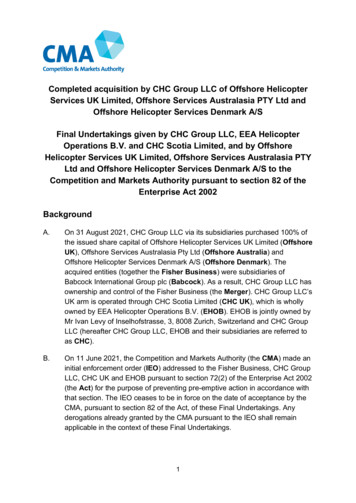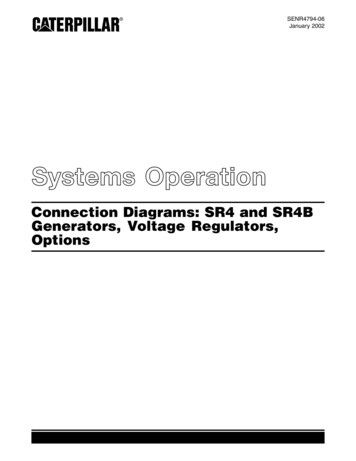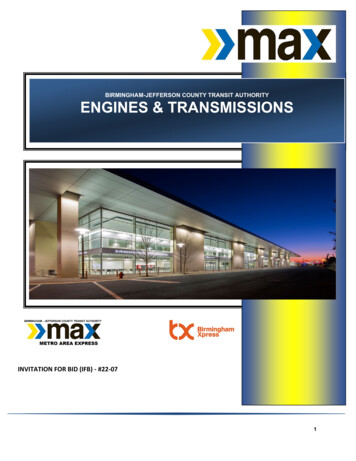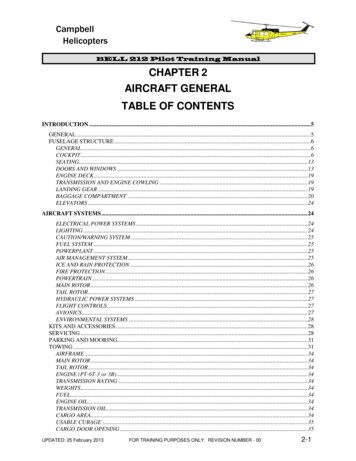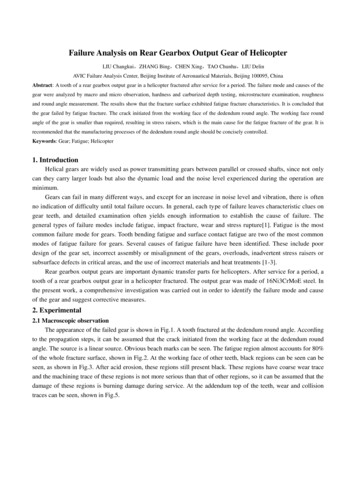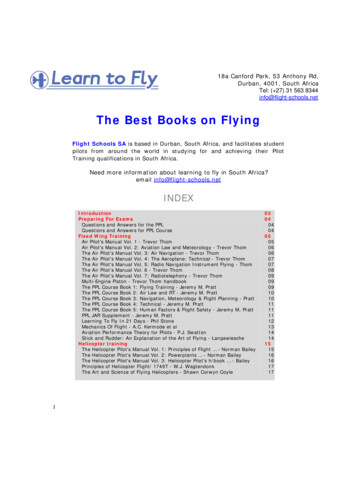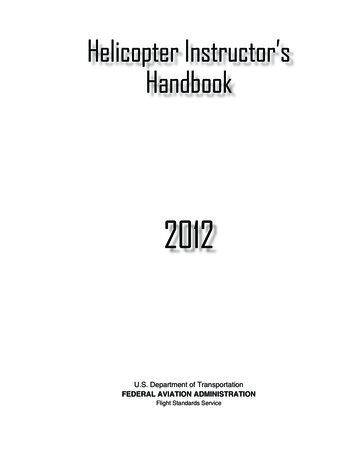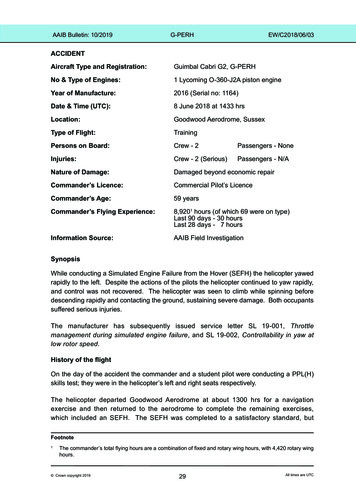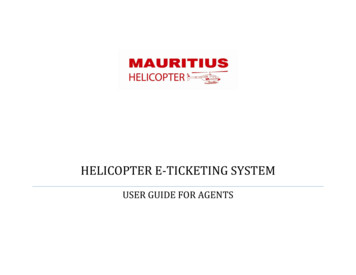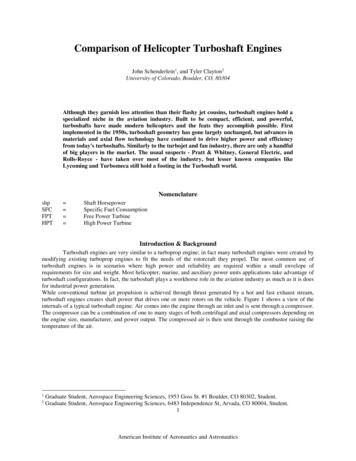
Transcription
Comparison of Helicopter Turboshaft EnginesJohn Schenderlein1, and Tyler Clayton2University of Colorado, Boulder, CO, 80304Although they garnish less attention than their flashy jet cousins, turboshaft engines hold aspecialized niche in the aviation industry. Built to be compact, efficient, and powerful,turboshafts have made modern helicopters and the feats they accomplish possible. Firstimplemented in the 1950s, turboshaft geometry has gone largely unchanged, but advances inmaterials and axial flow technology have continued to drive higher power and efficiencyfrom today's turboshafts. Similarly to the turbojet and fan industry, there are only a handfulof big players in the market. The usual suspects - Pratt & Whitney, General Electric, andRolls-Royce - have taken over most of the industry, but lesser known companies likeLycoming and Turbomeca still hold a footing in the Turboshaft world.NomenclatureshpSFCFPTHPT Shaft HorsepowerSpecific Fuel ConsumptionFree Power TurbineHigh Power TurbineIntroduction & BackgroundTurboshaft engines are very similar to a turboprop engine; in fact many turboshaft engines were created bymodifying existing turboprop engines to fit the needs of the rotorcraft they propel. The most common use ofturboshaft engines is in scenarios where high power and reliability are required within a small envelope ofrequirements for size and weight. Most helicopter, marine, and auxiliary power units applications take advantage ofturboshaft configurations. In fact, the turboshaft plays a workhorse role in the aviation industry as much as it is doesfor industrial power generation.While conventional turbine jet propulsion is achieved through thrust generated by a hot and fast exhaust stream,turboshaft engines creates shaft power that drives one or more rotors on the vehicle. Figure 1 shows a view of theinternals of a typical turboshaft engine. Air comes into the engine through an inlet and is sent through a compressor.The compressor can be a combination of one to many stages of both centrifugal and axial compressors depending onthe engine size, manufacturer, and power output. The compressed air is then sent through the combustor raising thetemperature of the air.12Graduate Student, Aerospace Engineering Sciences, 1953 Goss St. #1 Boulder, CO 80302, Student.Graduate Student, Aerospace Engineering Sciences, 6483 Independence St, Arvada, CO 80004, Student.1American Institute of Aeronautics and Astronautics
Figure 1: Inside of a typical turboshaft engineUpon exiting the combustor the air goes through the compressor turbine(s). Here the necessary power is extracted tooperate the compressor. Again the compressor turbine can be a single stage or many stages depending on the powerrequirements of the compressor. Finally the gas reaches the Free Power Turbine (FPT) and exhausted. This is themain difference between turboshaft and turboprop engines. As mentioned previously, the purpose of a turboshaftengine is to drive a rotor of the helicopter. The exhaust of the engine is not intended to provide much if any thrust tothe vehicle. The job of the FPT is to extract as much power from the gas and turn that into shaft power. In turn thepower shaft (shown in purple in Figure 1) connects to a gearbox and is then translated to the rotor itself. Note thatthe exhaust of the engine does not exit axially out the back of the turboshaft engine in all cases. Although Figure 1shows one implementation of a turboshaft, it is not consistent throughout the field. Many times the power shafttraverses through the entire engine to the front of the engine, and commonly the air inlets are at the rear of theengine. One other big difference between turboprops and turboshafts is that the stress of the rotor is not placed onthe engine in a turboshaft. The engine power shaft connects to a transmission/gearbox which is attached to the frameof the aircraft. The frame then takes the load and not the engine.Development of the gas turbines and turboshafts especially really picked up in the 1950s era. One of thefirst was the Turbomeca Artouste which was originally designed as an APU later becoming the Turmo engine.However, the first engine to power a helicopter was the Boeing T50 turboshaft, which flew on the Karam K225Synchropter in 1951. Today there are a few companies that lead the way, controlling the turboshaft market. Thesebeing: Pratt and Whitney Canada, Rolls-Royce, Turbomeca, Lycoming, and GE.Pratt and Whitney CanadaPWC is a division of the Pratt and Whitney company, however it performs its own research and development. It isbased out of Canada and focuses on the design, development, and manufacturing of smaller aircraft engines, inparticular turboprops and turboshafts. PWC started developing the PT6 turboprop in the 1950’s and launched in theearly ‘60s becoming its flagship product. Almost all of their turboshaft engines were derived from turboprops asthey are very similar in nature. Many variants, like the PT6B/C and PT6T Twin-Pac, found in Table 1, all camefrom the PT6A, falling in the 1000-2000 shp category. The Twin-Pac is made up of two of these PT6A engines thatmeet at a combining gearbox. Figures 2 and 3 show the PT6T engine. The first gives a side profile, including theinternal mechanics. It also shows the use of a reverse flow combustor. Figure 3 on the right shows an iso-view withthe combining gearbox on the front.2American Institute of Aeronautics and Astronautics
Figure 2:Inside of a PT6T engineFigure 3:PT6T engine with showing combining gearbox infrontTable 1: PWC Turboshaft Engine nsAW119 KoalaUH-1 Global EagleBell 212/412CH-146,AH1J SeaCobraEC135, Bell 429Power (shp)10001600-20001800-2200500-700Weight (lbs)385418660237Pressure Ratio7.1Unknown6.38Turbine inletTemp (K)UnknownUnknownUnknownUnknownSFC0.594 0.590.5960.548Compressorconfiguration3 axial, 1centrifugal4 axial, 1centrifugal3 axial,1 centrifugal1 centrifugalTurbineconfiguration2 HPT, 2 FPT2 HPT, 2 FPT2 HPT, 1 FPT each1 HPT, 1 FPTP/m (shp/lb)2.63.8-4.82.7-3.32.1-3.03American Institute of Aeronautics and Astronautics
Rolls-RoyceRolls-Royce is known as being one of the largest producers of power systems for air, land, and sea[**].They develop and manufacture all different kinds of engines for both commercial and defense for airplanes, marinevessels, and helicopters. The main turboshaft engines produced by RR are shown in Table 2. The M250 series is thebread and butter of their turboshaft sector. The M250 shown in Figure 4, was first developed by the Allison EngineCompany in the 1960s, and has been in production ever since. Allison Engine Company was later purchased byRolls-Royce in the ‘90s, becoming a subsidiary company. Today there have been over 31000 engines produced withabout half of them still in operation. The engine was designed to have the compressed air exiting the compressor issent to the rear of the engine around the turbine system and turns 180 degrees to enter the combustor. The exhaustair then leaves at the middle of the engine, shown by the two large openings in Figure 4.The engine has been applied to many different systems with over 40 variants. Of these, two of the mostinteresting applications are the RQ-8A unmanned helicopter produced by Northrop Grumman (Figure 5), and theMTT Turbine Superbike (Figure 6).Figure 5: Northrop Grumman RQ-8A Fire ScoutFigure 4: RR M250 turboshaft. Notice the color of paintindicating the temperature of the gases in that sectionFigure 6: The MTT Superbike uses an M250 turboshaft engineWith the success of the M250 series, RR developed a new slightly smaller engine, the RR300, based off the M250containing modern improvements to materials and manufacturing. The RR300 contains only a single centrifugalcompressor and with the traditional 4-stage turbine and puts out around 300 shp. At the current time, its majorapplication is to the Robinson R66 helicopter.4American Institute of Aeronautics and Astronautics
Table 2: RR Turboshaft Engine ComparisonEngineM250 SeriesRR300CTS800GEMNotableapplicationsRQ-8A, Fire Scout,Bell 206Robinson R66AW LynxAW LynxPower (shp)450-715240-3001300-16001000Weight (lbs)161-274176375414Pressure Ratio6.2-9.26.21412Turbine inletTemp pecific fuelconsumption (lb/lfhr)0.468Compressorconfiguration4-6 axial,1 centrifugal1 centrifugal2 centrifugal4 axial1 centrifugalTurbineconfiguration2 HPT, 2 FPT2 HPT, 2 FPT2 HPT, 2 FPT2 HPT, 2 FPTP/m (shp/lb)2.6-2.81.73.5-4.32.4One of the newer engines is the CTS800. This engine has been created by a joint venture between RR andHoneywell, called Light Helicopter Turbine Engine Company or LHTEC. The CTS800 produces a high pressureratio of 14 using only two centrifugal compressors.5American Institute of Aeronautics and Astronautics
Safran TurbomecaTurbomeca is a French manufacturer specializing in the design and production of small to medium sized helicopterengines ranging from 500 to 3000 shp. Currently about one of every three turboshaft engines employed onhelicopters are made by Turbomeca, with over 18,000 in operation *. By far, Turbomeca’s most popular engine isthe Arriel with almost 12,000 produced to date with over 30 certified variants. The engine falls in the 590-990 shpcategory weighing in at 245 lbs. Like the majority of Turbomeca’s engines it has a combined compressor consistingof centrifugal and axial stages. The only exception is the Ardiden engine, which has a two stage centrifugalcompressor.Table 3: Turbomeca Turboshaft Engine 2NotableapplicationsBell 505A109, S76CHALCheetah/Dhruv/ChetakRussian Ka62EurocopterAS532CougarAW AH-64DApachePower 2600Weight (lbs)223245367452615503Pressure RatioUnknown910Unknown1414.2Turbine inletTemp 30.529Unknown0.4810.45Compressorconfiguration1 centrifugal1 axial, 1centrifugal2 axial, 1centrifugal2 centrifugal3 axial,1 centrifugal3axial, 1centrifualTurbineconfiguration1 HPT, 2FPT2 HPT, 1FPT1 HPT, 1 FPT1 HPT, 2 FPT2 HPT, 2 FPT2 HPT, 2 FPTP/m (shp/lb)2.0-3.42.4-4.02.63.0-4.42.9-3.54.2-5.2One of the newest engines at Turbomeca is the Arrano. It fills a gap in the preceding table with a shaft power of1100 to 1300. The Arrano was designed to be more fuel efficient, claiming a 10-15% increase in the specific fuelconsumption of the engine. To do this many innovations were introduced to the design. These include a newthermodynamic core, with a dual-stage centrifugal compressor with variable-pitch inlet guide blades. It also usedadditive manufacturing to create the injectors for the combustion chamber. This engine has been selected as the solesource for the new twin-engined H160 from Airbus entering into service in 2018.Textron (Avco) LycomingPaving the way for turboshaft propulsion aboard modern helicopters, the Bell UH-1 “Huey” was powered by theLyocoming T53 turboshaft. In production since the early 1950s, the T53 was originally designed by Anselm Franz the man behind the famous Jumo 004 World War II turbojet. The T53 and the Huey it propelled would go on tosecure a definitive place for turboshaft driven military helicopters following its role in the Vietnam War. Today,Lycoming is a part of the Textron umbrella corporation, and produces turboshaft engines for aviation as well asother marine and military applications. The original Lycoming T53 that powered the UH-1 Huey (Figure 7) was a600 shp 688 lb engine in 1959. Today the T55 has replaced the T53, generating 4867 shp and weighing in at 831 lbs.6American Institute of Aeronautics and Astronautics
From the original T53 variant, the T55 produces more than eight times the thrust with only a 20% increase inFigure 7: The UH-1 Huey helicopter is powered by aLycoming T53.Figure 8: The popular transport helicopter, CH-47 Chinookweight. The more powerful T55 powers the twin rotor heavy-lifting Chinook helicopters (Figure 8).Table 4: Lycoming Turboshaft Engine ComparisonLyco EngineT53T55LTSNotable applicationsBell UH-1 HelicopterCH-47 ChinookHH-65 Coastguard SARHelicopterPower (shp)6004867675Weight (lbs)688831241Pressure Ratio7.39.328.4Turbine inlet Temp (K)Unknown1088UnknownSFC n5 axial, 1 centrifugal7 axial, 1 centrifugal1 axial, 1 centrifugalTurbine configuration1 HPT, 1 FPT2 HPT, 2 FPT1 HPT, 1 FPTP/m (shp/lb)0.875.62.8In addition to their role in the aviation turboshaft industry, Lycoming is responsible for turboshaft enginespowering US Army M1 Abrams tanks, turbine class locomotives, and the US Navy LCAC hovercraft. Outside ofturbine engines, Lycoming has made a name in general aviation, producing internal combustion engines that powerover half of the world’s general aviation aircraft.7American Institute of Aeronautics and Astronautics
Allison Engines (Rolls-Royce Allison)Allison Engines broke into the aircraft engine industry with the V-1710 V12 internal combustion engine. Over70,000 were produced for World War II fighters such as the P-39, P-40 and P-51. After the war, Allison used theirproduction capabilities to begin derivations of the General Electric Whittle engine. By 1953 Allison had begun onaxial flow engine designs, notably a “twinned” turboprop engine, the T40. Ultimately, Allison’s post-war enginedesign culminated in the creation of the T406 turboshaft, designed to power the unique V-22 OspreyTable 5: Allison Engine Turboshaft Engine ComparisonAllison EngineT406AE2100 (turboprop)250Notable applicationsV-22 OspreyLockheed C-130JHerculesHH-65 Coastguard SARHelicopterPower (shp)61504637250Weight (lbs)9711727136Pressure Ratio16.716.66.2Turbine inlet Temp (K)UnknownUnknown1258SFC n14 axial stages14 axial stages6 axial stages, 1centrifugalTurbine configuration2 HPT, 2 FPT2 HPT, 2 FPT2 HPT, 2 FPTP/m (shp/lb)6.32.71.8Figure 9: V-22 Osprey uses two T406 turboshaftsDespite being shrouded by complexity and controversy, the Osprey is undoubtedly one of the most unique andinnovative rotorcraft ever put into consistent production. Due to the power needed to both lift the aircraft as well as8American Institute of Aeronautics and Astronautics
propel it to 20,000 ft, an extremely powerful turboshaft is needed. The Allison/RR T406 engine is one of the mostpowerful turboshafts in production, and the most powerful examined by this paper. The shaft power out exceeds6000 shp.Beyond their involvement in turbomachinery, Allison was also one of the first engine manufactures to beginexperimenting with ceramic materials. In partnership with General Motors in the 1970s, they were successfulincorporating ceramics in automotive truck engines. Work continued on ceramic turbine components into the 1990s,however nothing significant ever came from the venture.General ElectricGeneral Electric (GE) is one of the giants in the aviation engine world. Known worldwide for their turbofanengines, they also produce many turboshaft engines. GE joined the aviation industry when they first begandeveloping the turbosupercharger for the U.S. government in 1917. It was designed to increase the power of a pistonengine at high altitude by using the exhaust gases to run an air compressor. From here GE’s influence in the fieldonly grew. They entered the turboshaft industry with the development of the T58 in the 1950s. Originally developedfor 800 shp, today it puts out more than 1200 shp. The T58 is the engine that drives Marine One, a Sikorsky SeaKing helicopter that carries the President of the United States.Table 6: General Electric Turboshaft onsSikorsky Sea king,Marine OneCH/MH-53EAH-64 ApacheSikorsky S-92Sikorsky CH-53KSuper StallionPower (shp)1250-18703925-47501900-26007500Weight (lbs)3917204501105Pressure Ratio8.314.91818.6Turbine inletTemp (K)Unknown900-1050UnknownUnknownSFC (kg/kW/hr).3890.466-0.480.46 .39*Compressorconfiguration10 axial14 axial5 axial1 centrifugal5 axial1 centrifugalTurbineconfiguration2 HPT, 1 FPT2 HPT, 2 FPT2 HPT, 2 FPT2 HPT, 3 FPTP/m (shp/lb)3.2-4.85.4-6.74.2-5.76.8Another popular helicopter ran by a GE engine the T700, is Boeing’s AH-64 Apache shown in Figure 10. Two ofthese engines, shown on the left of Figure 10, put out about 1900 shp each to power this aircraft.9American Institute of Aeronautics and Astronautics
Figure 10: GE's T700 turboshaft (left) which powers the AH-64 Apache (Right)The newest GE turboshaft is the GE38. It delivers an extreme amount of power, giving off 7500 shp. With this kindof power it is targeted at larger applications for heavy lifting. The engine is built to outperform its predecessor theT64, providing 57% more power and an estimated 63% fewer parts. No specific value for its sfc was found, but itclaims to be 18% more efficient than the T64. The GE38 fills a missing gap in the turboshaft industry, fallingbetween Europrops TP400-D6 (10,000 shp) and RR AE2100 (6000 shp). It has also been considered to replace theengines aboard the V-22 Osprey, pictured in Figure 9.Russian Turboshaft EnginesOften overlooked due to their age and lack of presence in the modern turboshaft industry, Soviet eraturboshafts were some of the most powerful produced, and can be found on dozens of helicopter models in servicearound the developing world. The major manufacturers are the Soleviev, Ivchenko-Lotarev, and Klimov DesignBureaus. Lotarev (Ukraine) was responsible for the powerful engines that made the largest aircraft in the worldpossible, Figure 11. Klimov built the infamous TV3-117, which powered over 95% of Russian helicopters, like theMi-24 pictures in Figure 12Figure 12: Russian Mi-24 helicopter powered by theTV3-117Figure 11: Russian Mi-26 Helicopter.10American Institute of Aeronautics and Astronautics
Table 7: Russian Turboshaft Engine ComparisonEngineKlimov TV3-117Klimov VK-2500Soloviev D-25Lotarev D-136Country of OriginSoviet RussiaSoviet RussiaSoviet RussiaSoviet UkraineNotableapplicationsVarious Kamov andMil Mi HelicoptersKamov Ka-50, MilMi-28Mil Mi-10Mil Mi-26Power (shp)220027003925-475011400Weight (lbs)64866113251077Pressure Ratio9.4UnknownUnknownUnknownTurbine inletTemp (K)1263UnknownUnknownUnknownSFC onUnknownUnknown9 axial5 axial1 centrifugalTurbineconfigurationUnknownUnknown1 HPT, 2 FPT2 HPT, 3 FPTP/m (shp/lb)3.44.13.0-3.610.58Comparisons & ConclusionDue to their use in helicopters, turboshaft engines are generally small in size, often utilizing at least one centrifugalcompressor, sometimes in parallel with two or more axial stages. Because helicopters become significantly moreinefficient as their size increase, extremely powerful turboshafts are not necessary; even the largest helicopters canutilize 2 or in some cases 4 turboshaft engines linked by a gearbox. Two soviet era Lotarev D-136 power the largestHelicopter ever produced, the Mil Mi-26, and produce 11400 shaft horsepower (a power/mass ratio over 10!).Typically engines in the 1000 shp and lower have power/mass ratios in the range of two to three. Engines from 2000to 3000 shp have ratios usually between three and four.Almost all of the turboshaft engines use 2 spool design. One to two high power turbines run the compressor and therest of the power extraction is performed by usually 2 free power turbines. The larger engines like the D-136 andGE38 use 3 FPTs. Earlier versions like GE’s T58 and T68 used a completely axial turbine, almost every turboshaftnow uses a combination of at least one centrifugal. In fact some engines like Turbomecas Ardiden and RR CST800use only a dual centrifugal compressor, and still achieve pressure ratios around 14. The highest found for this reportwas 18.6 from the GE38 engine, (a combination of 5 axial and 1 centrifugal). Older turboshaft engines have aspecific fuel consumption in the 0.5-0.6 kg/kW/hr range while newer engines have improved close to 0.39 (GE38).11American Institute of Aeronautics and Astronautics
The aerospace industry is constantly changing, and turboshafts are not an exception to this. Driven by the constantpressure of competitors along with new technologies and manufacturing techniques, companies have to doeverything in their power to maintain or increase their footprint in the field. This paper has given some insight intothe many available engines on the turboshaft market and the companies behind them. Of course not all of thecompanies are listed here, but the major game players in the industry were.AcknowledgmentsWe would like to acknowledgments Dr. Lakshmi Kantha for his extensive notes and in class lectures.References[1]"At a glance" Turbomeca. Web. 17 Dec. 2015. http://www.turbomeca.com/company#1 .[2]"The CT7 Engine." GE Aviation. General Electric, Web. 17 Dec. 2015. http://www.geaviation.com/commercial/engines/ct7/ .[3]"D-136 Gas Turbine Turboshaft Aero Engine." Ivchenko Progress. Ivchenko-Lotarev, 2015. Web. 17 Dec. 2015. http://ivchenko-progress.com/?portfolio d136&lang en .[4]"Helicopters." Rolls-Royce Products. Rolls-Royce, Web. 17 Dec. 2015. ace/products/helicopters/ .[5]"Military Engines." GE Aviation. General Electric, n.d. Web. 17 Dec. 2015. http://www.geaviation.com/military/engines/ .[6]"Military Turboshaft/Turboprop Specifications." Military Turboshaft/Turboprop Specifications. Web. 17 Dec.2015. http://www.jet-engine.net/miltsspec.html .[7]"Turboprop and Turboshaft Engines." Subject. Web. 17 Dec. 2015. https://engineering.purdue.edu/ propulsi/propulsion/jets/tprops.html .[8]"TV3-117." Klimov. JSC Klimov United Engine Corporation, 2015. Web. 17 Dec. 2015. http://klimov.ru/en/production/helicopter/TV3-117/ .[9]"VK-2500." Klimov. JSC Klimov United Engine Corporation, 2015. Web. 17 Dec. 2015. http://klimov.ru/en/production/helicopter/VK-2500/ .[10]"What We Do." Rolls Royce About. Rolls Royce, 2015. Web. 17 Dec. 2015. http://www.rollsroyce.com/about.aspx .[11] Emoscopes. Turboshaft Operation. Wikimedia Commons.[12] "Allison (MTU) 250 C20B." Wikipedia. Wikimedia Foundation. Web. 17 Dec. 2015. https://en.wikipedia.org/wiki/Allison Model 250#/media/File:Allison (MTU) 250 C20B.jpg .[13] "CT7 T700." Wikipedia. Wikimedia Foundation. Web. 17 Dec. 2015. https://en.wikipedia.org/wiki/General Electric T700#/media/File:CT7 T700 P1220751.jpg .[14] Caya, Sgt. Michael R. "CH-47F at NTC 2008." Wikipedia. Wikimedia Foundation. Web. 17 Dec. 2015. https://en.wikipedia.org/wiki/Boeing CH-47 Chinook#/media/File:CH-47F at NTC 2008.jpg .[15] Cheung, Master Sgt. Lance. "U.S. Air Force TH-1 Huey." Wikipedia. Wikimedia Foundation. Web. 17 Dec.2015. https://en.wikipedia.org/wiki/Bell UH-1 Iroquois#/media/File:U.S. Air Force TH-1 Huey.JPG .[16] Dunaway, Tech. Sgt. Andy. "AH-64D Apache Longbow." Wikipedia. Wikimedia Foundation. Web. 17 Dec.2015. https://en.wikipedia.org/wiki/Boeing AH-64 Apache#/media/File:AH-64D Apache Longbow.jpg .[17] "MTT Streetfighter Turbine." Wikipedia. Wikimedia Foundation. Web. 17 Dec. 2015. https://en.wikipedia.org/wiki/MTT Turbine Superbike#/media/File:MTT Streetfighter Turbine - Flickr Supermac1961.jpg .[18] "RR/Allison 250." Web. 17 Dec. 2015. http://www.enginehistory.org/GasTurbines/Allison/7 RR ALLISON250-B17F.jpg .[19] "Russian Air Force Mil Mi-24P Dvurekov." Wikipedia. Wikimedia Foundation. Web. 17 Dec. 2015. https://en.wikipedia.org/wiki/Mil Mi-24#/media/File:Russian Air Force Mil Mi-24P Dvurekov-4.jpg .[20] Schindler, Kelly. "An MQ-8B Fire Scout Unmanned Aerial Vehicle." Web. 15 Dec. 2015.12American Institute of Aeronautics and Astronautics
Matlab Codeclear all; close all; clc%% Givensgamma 1.4;gam c 1.4;% for temps through compressor,combustorgam t 1.33;% for temps after the combuster - turbinec 1005;cpc 1004;cpt 1156;% specific heat% for temps in the compressor,combustor% for temps in the turbinehp2W 0.7457*1000; % conversion from hp to Wlb2kg 0.453592; % conversion from lb to kg%T5 T9 T0 (should be ambient for maximum)%p5 p9 p0%M 0% Ambient ValuesM0 0;% Mach[T0,a0,P0,rho0] atmosisa(0); % Standard Atmospher [K,m/s,kg/m3,Pa]mdot 26*lb2kg;% Air mass flow rate [kg/s]hpr 42.8e6;% Fuel Heating value [J]Tt4 1100 273.15;% Turbine Entry Temperatureb[K]P 4230*hp2W;% Power extracted to turboshaftPi c ---------------------------ec .92;% Polytropic Efficiency of Compressoret .92;% Polytropic Efficiency of TurbineEta b .96;% Efficiency of burner (combustor)eta c .85; %power conversion losses, 1 no loss%%tau r 1 .5*(gamma-1)*M0 2;% Tt0/T0 : stagnation to static Temp Ratiotau c Pi c ((gamma-1)/gamma); % Tt3/T2 : compressortau lam Tt4/T0;% ht4/ht0 cpt*Tt4/cpc*T0tau tH 1-(tau r/tau lam)*(tau c-1);%tau tL, tau t for a turboshafttau tL 1-(1/(tau lam*tau tH))*(P/(mdot*c*T0));tau t tau tH*tau tL;%tau tL, tau t for a turboprop%{tau t 1/(tau r*tau c) (gamma-1)*M0 2/(2*tau lam*eta c 2);tau tL tau t/tau tH;%}Sp (a0*M0) 2*(1/eta c-1) .13American Institute of Aeronautics and Astronautics
cpc*T0*tau lam*tau tH*(1-tau tL)*eta c;f cpc*T0*(tau lam-tau r*tau c)/hpr;Spfc f/Sp *3600*1000eta 0 Sp/(c*T0*(tau lam-tau r*tau c));eta th 1-(1/(tau r*tau c))eta P eta 0/eta th;%% realtau r tau c tau lamcycle1 .5*(gam c-1)*M0 2;% Tt0/T0 : stagnation to static Temp RatioPi c ((gam c-1)/(ec*gam c)); % Tt3/T2 : compressor cpt*Tt4/(cpc*T0);tau tH 1-tau r/tau lam*(tau c-1);%tau tL, tau t for a turboshafttau tL 1-(1/(tau lam*tau tH))*(P/(mdot*cpt*T0));tau t tau tH*tau tL;%tau tL, tau t for a turboprop%{tau t 1/(tau r*tau c) (gamma-1)*M0 2/(2*tau lam*eta c 2);tau tL tau t/tau tH;%}Sp (a0*M0) 2*(1/eta c-1) . cpc*T0*tau lam*tau tH*(1-tau tL)*eta c;f cpc*T0/(Eta b*hpr)*(tau lam-tau r*tau c);Spfc real f/Sp *3600*1000eta 0 Sp/(gam c*T0*(tau lam-tau r*tau c));eta th 1-(1/(tau r*tau c))eta P eta 0/eta th;14American Institute of Aeronautics and Astronautics
American Institute of Aeronautics and Astronautics Rolls-Royce Rolls-Royce is known as being one of the largest producers of power systems for air, land, and sea[**]. They develop and manufacture all different kinds of engines for both commercial and defense for airplanes, marine vessels, and helicopters.
